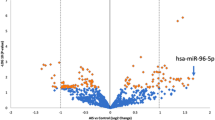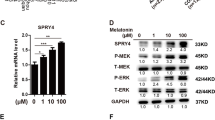Abstract
Purpose
Adolescent Idiopathic Scoliosis (AIS) is considered a complex genetic disease, in which malfunctioning or dysregulation of one or more genes has been proposed to be responsible for the expressed phenotype. However, to date, no disease causing genes has been identified and the pathogenesis of AIS remains unknown. The aim of this study is, therefore, to identify specific molecules with differing expression patterns in AIS compared to healthy individuals.
Methods
Microarray analysis and quantitative RT-PCR have examined differences in the gene transcription profile between primary osteoblasts derived from spinal vertebrae of AIS patients and those of healthy individuals.
Results
There are 145 genes differentially expressed in AIS osteoblasts. A drastic and significant change has been noted particularly in the expression levels of Homeobox genes (HOXB8, HOXB7, HOXA13, HOXA10), ZIC2, FAM101A, COMP and PITX1 in AIS compared to controls. Clustering analysis revealed the interaction of these genes in biological pathways crucial for bone development, in particular in the differentiation of skeletal elements and structural integrity of the vertebrae.
Conclusions
This study reports on the expression of molecules that have not been described previously in AIS. We also provide for the first time gene interaction pathways in AIS pathogenesis. These genes are involved in various bone regulatory and developmental pathways and many of them can be grouped into clusters to participate in a particular biological pathway. Further studies can be built on our findings to further elucidate the association between different biological pathways and the pathogenesis of AIS.



Similar content being viewed by others
References
Je L (1995) Idiopathic Scoliosis. In: Winter RB, Ogilive JW (eds) Lonstein JE BD. Moe’s textbook of scoliosis and other spinal deformaties. WB Saunders, Philadelphia, pp 219–256
Cavallaro Goodman C, Fuller KS (2009) Pathology: implications for the physical therapist. Saunders. WB/CO, St. Louis
Winter RB (1979) Posterior spinal fusion in scoliosis: indications technique and results. Orthop Clin N Am 10:787–800
Dubousset JQP, Thillard M (1983) Experimental scoliosis induced by pineal and diencephalic lesions in young chickens: its relation with clinical findings. Orthop Trans 7:7–12
Machida M, Dubousset J, Imamura Y, Miyashita Y, Yamada T, Kimura J (1996) Melatonin a possible role in pathogenesis of adolescent idiopathic scoliosis. Spine 21:1147–1152
Taylor TK, Ghosh P, Bushell GR (1981) The contribution of the intervertebral disk to the scoliotic deformity. Clin Orthop Relat Res 156:79–90
Sahlstrand T, Petruson B (1979) A study of labyrinthine function in patients with adolescent idiopathic scoliosis I. An electro-nystagmographic study. Acta orthop Scand 50:759–769
Kindsfater K, Lowe T, Lawellin D, Weinstein D, Akmakjian J (1994) Levels of platelet calmodulin for the prediction of progression and severity of adolescent idiopathic scoliosis. J Bone Jt Surg Am 76:1186–1192
Nissinen M, Heliovaara M, Seitsamo J, Poussa M (1993) Trunk asymmetry. posture. growth. and risk of scoliosis. A three-year follow-up of Finnish prepubertal school children. Spine 18:8–13
Wise CA, Barnes R, Gillum J, Herring JA, Bowcock AM, Lovett M (2000) Localization of susceptibility to familial idiopathic scoliosis. Spine 25:2372–2380
Edery P, Margaritte-Jeannin P, Biot B, Labalme A, Bernard JC, Chastang J, Kassai B, Plais MH, Moldovan F, Clerget-Darpoux F (2011) New disease gene location and high genetic heterogeneity in idiopathic scoliosis. Eur J Hum Genet 19:865–869. doi:10.1038/ejhg.2011.31
Sharma S, Gao X, Londono D, Devroy SE, Mauldin KN, Frankel JT, Brandon JM, Zhang D, Li QZ, Dobbs MB, Gurnett CA, Grant SF, Hakonarson H, Dormans JP, Herring JA, Gordon D, Wise CA (2011) Genome-wide association studies of adolescent idiopathic scoliosis suggest candidate susceptibility genes. Hum Mol Genet 20:1456–1466. doi:10.1093/hmg/ddq571
Letellier K, Azeddine B, Parent S, Labelle H, Rompre PH, Moreau A, Moldovan F (2008) Estrogen cross-talk with the melatonin signaling pathway in human osteoblasts derived from adolescent idiopathic scoliosis patients. J Pineal Res 45:383–393. doi:10.1111/j.1600-079X.2008.00603.x
Chan V, Fong GC, Luk KD, Yip B, Lee MK, Wong MS, Lu DD, Chan TK (2002) A genetic locus for adolescent idiopathic scoliosis linked to chromosome 19p13.3. Am J Hum Genet 71:401–406. doi:10.1086/341607
Montanaro L, Parisini P, Greggi T, Di Silvestre M, Campoccia D, Rizzi S, Arciola CR (2006) Evidence of a linkage between matrilin-1 gene (MATN1) and idiopathic scoliosis. Scoliosis 1:21. doi:10.1186/1748-7161-1-21
Ocaka L, Zhao C, Reed JA, Ebenezer ND, Brice G, Morley T, Mehta M, O’Dowd J, Weber JL, Hardcastle AJ, Child AH (2008) Assignment of two loci for autosomal dominant adolescent idiopathic scoliosis to chromosomes 9q31.2-q34.2 and 17q25.3-qtel. J Med Genet 45:87–92. doi:10.1136/jmg.2007.051896
McNulty CL, Peres JN, Bardine N, van den Akker WM, Durston AJ (2005) Knockdown of the complete Hox paralogous group 1 leads to dramatic hindbrain and neural crest defects. Development 132:2861–2871. doi:10.1242/dev.01872
Pollock RA, Sreenath T, Ngo L, Bieberich CJ (1995) Gain of function mutations for paralogous Hox genes: implications for the evolution of Hox gene function. Proc Natl Acad Sci USA 92:4492–4496
Yang X, Ji X, Shi X, Cao X (2000) Smad1 domains interacting with Hoxc-8 induce osteoblast differentiation. J Biol Chem 275:1065–1072
Riggs BL, Khosla S, Melton LJ 3rd (2002) Sex steroids and the construction and conservation of the adult skeleton. Endocr Rev 23:279–302
Mortlock DP, Innis JW (1997) Mutation of HOXA13 in hand-foot-genital syndrome. Nat Genet 15:179–180. doi:10.1038/ng0297-179
Logan M, Tabin CJ (1999) Role of Pitx1 upstream of Tbx4 in specification of hindlimb identity. Science 283:1736–1739
Gurnett CA, Alaee F, Kruse LM, Desruisseau DM, Hecht JT, Wise CA, Bowcock AM, Dobbs MB (2008) Asymmetric lower-limb malformations in individuals with homeobox PITX1 gene mutation. Am J Hum Genet 83:616–622. doi:10.1016/j.ajhg.2008.10.004
Briggs MD, Chapman KL (2002) Pseudoachondroplasia and multiple epiphyseal dysplasia.: mutation review molecular interactions, and genotype to phenotype correlations. Hum Mutat 19:465–478. doi:10.1002/humu.10066
Fendri K, Moldovan F (2011) Potential role of COMP as a biomarker for adolescent idiopathic scoliosis. Med Hypotheses 76:762–763. doi:10.1016/j.mehy.2011.01.038
Tsui FW, Haroon N, Reveille JD, Rahman P, Chiu B, Tsui HW, Inman RD (2010) Association of an ERAP1 ERAP2 haplotype with familial ankylosing spondylitis. Ann Rheum Dis 69:733–736. doi:10.1136/ard.2008.103804
Hamilton JP (2011) Epigenetics: principles and practice. Dig Dis 29:130–135. doi:10.1159/000323874
Silahtaroglu A, Stenvang J (2010) MicroRNAs epigenetics and disease. Essays Biochem 48:165–185. doi:10.1042/bse0480165
Burwell RG, Dangerfield PH, Moulton A, Grivas TB (2011) Adolescent idiopathic scoliosis (AIS), environment. exposome and epigenetics: a molecular perspective of postnatal normal spinal growth and the etiopathogenesis of AIS with consideration of a network approach and possible implications for medical therapy. Scoliosis 6:26. doi:10.1186/1748-7161-6-26
Qiu XS, Tang NL, Yeung HY, Lee KM, Hung VW, Ng BK, Ma SL, Kwok RH, Qin L, Qiu Y, Cheng JC (2007) Melatonin receptor 1B (MTNR1B) gene polymorphism is associated with the occurrence of adolescent idiopathic scoliosis. Spine (Phila Pa 1976) 32(16):1748–1753
Wu J, Qiu Y, Zhang L, Sun Q, Qiu X, He Y (2006) Association of estrogen receptor gene polymorphisms with susceptibility to adolescent idiopathic scoliosis. Spine (Phila Pa 1976) 31(10):1131–1136
Alden KJ, Marosy B, Nzegwu N, Justice CM, Wilson AF, Miller NH (2006) Idiopathic scoliosis: identification of candidate regions on chromosome 19p13. Spine (Phila Pa 1976) 31(16):1815–1819
Raggio CL, Giampietro PF, Dobrin S, Zhao C, Dorshorst D, Ghebranious N, Weber JL, Blank RD (2009) A novel locus for adolescent idiopathic scoliosis on chromosome 12p. J Orthop Res 27:1366–1372
Justice CM, Miller NH, Marosy B, Zhang J, Wilson AF (2003) Familial idiopathic scoliosis: evidence of an X-linked susceptibility locus. Spine 28:589–594
Salehi LB, Mangino M, De Serio S, De Cicco D, Capon F, Semprini S, Pizzuti A, Novelli G, Dallapiccola B (2002) Assignment of a locus for autosomal dominant idiopathic scoliosis (IS) to human chromosome 17p11. Hum Genet 111:401–404
Acknowledgments
FM and PE were supported by Yves Cotrel Foundation and SAP was supported by CHU Sainte-Justine and Foundation of the Stars scholarship.
Conflict of interest
None.
Author information
Authors and Affiliations
Corresponding author
Rights and permissions
About this article
Cite this article
Fendri, K., Patten, S.A., Kaufman, G.N. et al. Microarray expression profiling identifies genes with altered expression in Adolescent Idiopathic Scoliosis. Eur Spine J 22, 1300–1311 (2013). https://doi.org/10.1007/s00586-013-2728-2
Received:
Revised:
Accepted:
Published:
Issue Date:
DOI: https://doi.org/10.1007/s00586-013-2728-2




